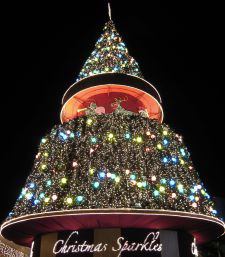 For many of us, the holiday season is a chance to plan special meals, wrap gifts, and delight in family traditions.
For many of us, the holiday season is a chance to plan special meals, wrap gifts, and delight in family traditions.
Yet while our familiar traditions are tried-and-true, traveling during the holidays is a wonderful way to experience other cultures’ traditions. Communities throughout Europe (and around the world) gather each year for regional rituals and charming traditions that we don’t often hear about.
And best of all, airfares and hotel prices in these destinations are often less expensive in the winter months. (Click here to learn more from Peter about European winter savings.) So head to Europe in the winter, and you get the best of both worlds: an affordable vacation while adding a bit of spice to your holiday medley.
German Christmas Markets
For many of us, Christmas is about those sweet smells, joyful music, inspired shopping trips, and warm feelings of holiday cheer. Throughout Europe, Christmas markets pack all of these holiday delights into one place.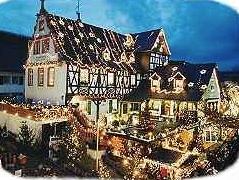 In Germany, markets open in most towns in late November and continue to run daily through Christmas Eve between 10 a.m. and 8 p.m. Creative inspiration and careful planning go into the construction of these markets year after year, and over time they have each developed their own identity and become the pride of their communities.
In Germany, markets open in most towns in late November and continue to run daily through Christmas Eve between 10 a.m. and 8 p.m. Creative inspiration and careful planning go into the construction of these markets year after year, and over time they have each developed their own identity and become the pride of their communities.
Whether you prefer the personalized charm of the romantic country villages or are drawn to the frenzied bustle of the larger cities, you will find that each market you find has a unique specialty infused with a local spirit. Holiday shoppers will have more then their fill as they examine the selection of handmade crafts and timeless treasures. Come with an appetite, as steaming mulled wine, baked apples, spicy gingerbread biscuits (lebkuchen), sweet marzipan, and hot roasted chestnuts are just some of the culinary treats that will tempt you as you stroll along.
While each market sparkles in its own right, Nuremberg’s famous “Christ Child Market” is a standout. The smell of cinnamon and cloves fills the air as you wander through row upon row of dazzling stalls selling an unmatched array of gifts and goodies. In addition, a traditional two-tiered carousel calls out to good little children and invites them to come and play.
In Dresden, you will find Germany’s oldest Christmas Market, called the Striezelmarkt, which has been running since 1434. Sample the spicy gingerbread, called Pulsnitz Pfefferkuchen, or the Christstollen, a Dresden specialty. This rich, dried fruit-studded yeast bread is the feature of the town’s Stollen Festival celebrated each year on the Saturday before the second Sunday in Advent.
If you are set on taking home some local crafts, the market will not disappoint. Handcrafted wooden figurines from the Erzgebirge Mountains, handmade lace, hand-blown tree ornaments, and pottery from Lusatia are just some of the gifts available from the maze of booths clustered throughout the central square.
Romantic Rothenberg, in the heart of Bavaria, retains a medieval charm within its quiet squares and cobblestone streets. It offers a collection of impressive churches and architectural gems within its imposing city walls, and is also home to the German Christmas museum. Don’t miss sampling the schneeball, a village treat of fried sweet dough covered in powdered sugar or chocolate.
Click here for a full list of markets running in towns throughout Germany or for additional information about the location or specialties of a specific market.
If you can’t decide which town you want to visit, Grand Circle Travel offers Christmas market cruise tours down the Danube or the Rhine. Each itinerary allows you time to shop and stroll to your hearts content at ports carefully selected for their well-appointed markets. Trips include transatlantic air, transfers, accommodation, and all meals. The Danube tour takes you to visit the Nuremburg, Regensburg, and Passau markets in Germany before crossing the Austrian border to make stops in Linz and Melk.
On the Rhine cruise, travel through Switzerland, France, Germany, and the Netherlands on a 12-day journey that showcases the most enchanting spots in the region. 800-959-0405, www.gct.com
The Legend of St. Nicholas
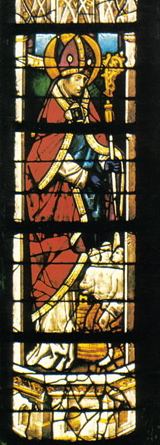 Searching for the real Santa Claus? Well, that would be St. Nicholas of course. A faithful man renowned for his goodness and generosity, Nicholas is the inspiration for the legend and tradition of Santa Claus.
Searching for the real Santa Claus? Well, that would be St. Nicholas of course. A faithful man renowned for his goodness and generosity, Nicholas is the inspiration for the legend and tradition of Santa Claus.
He was a historical figure who lived from 271 to 342 AD near the city of Anatolia in present-day Turkey. His legacy is celebrated in countries throughout Europe on December 6 each year.
In France, the smell of spiced gingerbread cookies and mannala—a brioche in the shape of the featured saint—waft out of kitchens and bakeries in celebration of jolly old St. Nicholas (or “Nicolas” as the French would say).
On the night of December 5, children place their shoes near the chimney before bed in the hope that St. Nicholas will visit during the night to fill them with chocolates, nuts, cookies, and other sweet treats. However, if they’ve been naughty, they will find little bundles of twigs in their shoes that aren’t nearly as sweet.
In the region of Lorraine where Nicholas holds the title of patron saint, the city of Saint-Nicolas-de-Port holds a famed day-long celebration on December 6. The entire town gathers in the streets to enjoy traditional live music, home baked treats, and a colorful parade of lovingly designed floats. It is tradition for the mayor to award St. Nicholas the key to the city, and the festivities to end with an evening firework display.
In the Netherlands, the Dutch delight over the Feast of Sinterklaas, their version of St. Nicholas. The festival is celebrated on the evening of December 5, and emphasizes the joy of giving gifts with originality rather than commercial value.
The Dutch gather together to enjoy a feast of traditional sweets and baked goods such as gingerbread men and woman referred to as “lovers.” Large chocolate letters in the first initial of each family member serve as place markers for the meal. Community gatherings are held throughout the towns for the reading of poetry and the singing of songs.
Scandinavian Saint’s Day
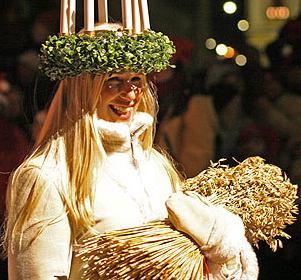 In Scandinavian countries, December 13 marks the celebration of St. Lucia day. This internationally recognized feast day recognizes Lucia, Queen of Light, a fourth-century virgin and martyr who survived perishing in the flames when she was sentenced to death for her beliefs.
In Scandinavian countries, December 13 marks the celebration of St. Lucia day. This internationally recognized feast day recognizes Lucia, Queen of Light, a fourth-century virgin and martyr who survived perishing in the flames when she was sentenced to death for her beliefs.
This festival day takes on special meaning in towns and villages throughout Sweden. On this day each year the oldest daughter in the household will rise early in the morning to bring coffee, mulled wine, gingerbread biscuits, and specially prepared saffron buns, called lussekatt, to her parents. Dressed in a long white gown and balancing a crown of candles on her head, she’s supposed to enter the room singing a traditional St. Lucia Song.
Official Lucias are selected regionally to carry out public rituals and community activities in towns throughout Sweden, and from these one national Lucia is selected to represent the country.
In the capital city of Stockholm, the Lucia is crowned at 5 p.m. on December 12 with a sing-along. The following day, she travels on a horse-drawn carriage through city streets lavishly draped in lights before finally ending her procession in Skansen, the city’s illustrious open-air museum of Swedish life. Here she is met by a crowd and all are treated to a lavish firework display.
The occasion is also celebrated with candlelight concerts of traditional music held in churches and concert halls throughout the city. Enjoying a seasonal concert allows you extended time to marvel the ornate interiors of Stockholm churches while you savor the heightened experience of listening to the traditional spiritual melodies in the venues where they were meant to performed.
Concerts take place in Kungsholmen, St. Jacob’s, Aldof Fredrik’s, Katarina, and Oscar churches throughout the day on December 13, but the grandest concerts are given in the Storkyrkan Cathedral known as the “Great Church” in the old town region of Gamla Stan on December 12 at 7 p.m. and December 13 at 6 p.m.
Looking to stay healthy while you’re in Stockholm? Find out how.
Christmas in the Arctic Circle
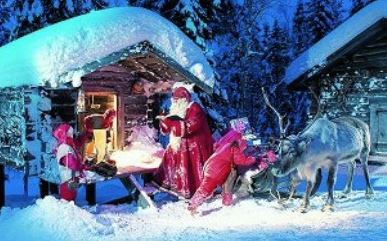 Looking to escape to a real-life winter wonderland? Make the journey to the far north region of Finnish Lapland, the unofficial home of Father Christmas. Lapland is a region of the Arctic Circle that extends into both Sweden and Finland.
Looking to escape to a real-life winter wonderland? Make the journey to the far north region of Finnish Lapland, the unofficial home of Father Christmas. Lapland is a region of the Arctic Circle that extends into both Sweden and Finland.
Locals claim that Santa Claus makes the commute from Korvatunturi in Eastern Finnish Lapland to the capital city of Rovaniemi each day where he welcomes visitors year round in the Santa Claus Village (www.santapark.com).
In fact, each year the Santa’s Post Office located in the city is flooded with more than 700,000 letters written by hopeful children from all over the world. The village is great for wandering, and contains many Christmas-related spectacles.
Take your children on a sleigh ride to Santa’s workshop where elves hammer away vigorously at their projects. The Christmas House provides visitors with a history of Christmas, while at the Ice Gallery you can gape at skillfully chiseled ice sculptures while sipping on a warm glass of mulled wine.
Besides the festive Christmas rituals, the area also offers the opportunity to experience the kind of fantasy winter sports you can’t try just anywhere. Facilities for ice skating, skiing, reindeer sleigh and husky sled rides, and ice fishing are all located in the near vicinity.
The agency Magic of Lapland organizes trips and itineraries that punctuate excursions tackling Rovaniemi’s outdoor sports activities with indoor defrost breaks that refuel visitors with traditional Finnish pancake breakfasts and plenty of cheer.
From Russia with Love
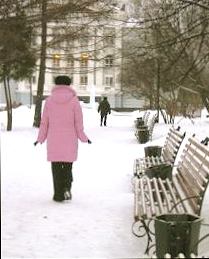 Each year, the Russian Winter Festival takes over in major cities throughout the country and gives locals and visitors the chance to mingle, celebrate the winter season, and welcome the arrival of the New Year. This 12-day extravaganza parallels the Western tradition of the 12 days of Christmas. Festivities include live performances from renowned musical guests and the opportunity to eat, drink and be merry.
Each year, the Russian Winter Festival takes over in major cities throughout the country and gives locals and visitors the chance to mingle, celebrate the winter season, and welcome the arrival of the New Year. This 12-day extravaganza parallels the Western tradition of the 12 days of Christmas. Festivities include live performances from renowned musical guests and the opportunity to eat, drink and be merry.
In Moscow, this year’s festival is being held from December 25, 2007 to January 5, 2008 in Izmailovo Park. Father Frost, the Snow Maiden, and a team of jolly Russian Buffoons will be stationed and ready to greet and welcome guests. Featured activities include folk games, sleigh rides through the forest, dancing, and lots of Russian folk music. If all the merry-making makes your stomach growl, hearty Russian delicacies such as pancakes with caviar will be sure to satisfy your cravings.
The St. Petersburg version of the festival runs from December 28, 2007 through January 7, 2008, and boasts a similarly full schedule of performances and activities.
Word of the festival’s popularity has spread so that in recent years the tradition has made its way all the way across Europe to London, where the British pay tribute to their Russian friends by holding a similar annual festival in Trafalgar Square. On the eve of the Russian “Old New Year” the Russian-British Culture Association known as Eventica hosts the largest gathering of its kind outside the Russian federation to celebrate the spirit and influence of Russian culture.
The Festival will celebrate its fourth consecutive year on January 13, 2008. +44 (0) 20 7183 2560.
Need more info on travel to Russia? Don’t miss Off the Brochure: Moscow for more.
Sparkling Skies
 Aside from regional cultural celebrations this is also the season to appreciate nature’s own winter tradition, the aurora borealis, or northern lights. The northern lights are an unmatched visual spectacle, visible each year in the skies of the Arctic Circle from October through March.
Aside from regional cultural celebrations this is also the season to appreciate nature’s own winter tradition, the aurora borealis, or northern lights. The northern lights are an unmatched visual spectacle, visible each year in the skies of the Arctic Circle from October through March.
One of the most enchanting ways to combine a front-row view of the light display with a tour of some of the land bound winter delights is by taking a coastal cruise. This time of year, many agencies offer trips specially formatted to give you a taste of culture and maximum opportunities to enjoy the northern lights.
Hurtigruten offers Aurora Borealis cruises up the Norwegian coast departing from Bergen from October 1 through March 31, as well as a selection of other winter-themed trips. Visit the Gothic Cathedral in Trondheim, visit the capital of Oslo, or choose from 33 other ports on itineraries ranging from 7 to 12 days in duration. 866-257-6071, www.hurtigruten.us
By Alix Proceviat for PeterGreenberg.com.
Want information about foodie-focused voyages? Check out our Culinary Travel section.
Need hints on getting to Europe? Try Cheap, “Secret” Intercontinental Flights for Europe, Asia & America.












